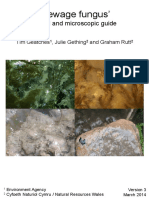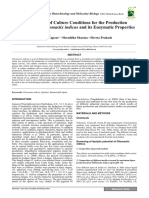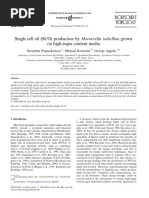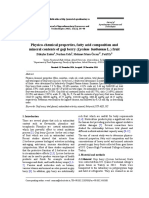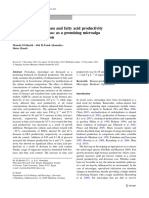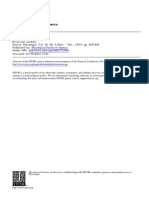Lipase Production by Geotrichum Candidum-M2
Lipase Production by Geotrichum Candidum-M2
Uploaded by
AparnaCopyright:
Available Formats
Lipase Production by Geotrichum Candidum-M2
Lipase Production by Geotrichum Candidum-M2
Uploaded by
AparnaOriginal Title
Copyright
Available Formats
Share this document
Did you find this document useful?
Is this content inappropriate?
Copyright:
Available Formats
Lipase Production by Geotrichum Candidum-M2
Lipase Production by Geotrichum Candidum-M2
Uploaded by
AparnaCopyright:
Available Formats
Bulletin of the Chemists and Technologists of Macedonia, Vo!. 20, No. 1, pp.
39-43 (2001)
GHTMDD - 373 ISSN 0350 - 0136
Received: July 3, 2000 DDC: 663.152.311 : 582.28
Accepted: April 2, 2001
Original scientific paper
LIPASE PRODUCTION BY GEOTRICHUM CANDIDUM-M2
Irina Mladenoska*, Aco Dimitrovski
Faculty of Technology and Metallurgy, The "Sv. Kiril & Metodij" University,
Rudjer Bos'kovic16, MK-lOOO Skopje, Republic of Macedonia
*E-mail: irinaetf@mt.net.mk
Investigation on the effects of fermentation conditions and culture medium composition on lipase production
by the yeast-like fungus Geotrichum candidum-M2 has been performed. The sunt10wer oil sediment was tested as
carbon source and compared to several other oils and carbohydrates. It was proven as the best carbon source, whereas
the yeast extract was the best nitrogen source. The culture medium selected as optimal one contained each of them in
concentration of 1 %. Maximum lipolytic activity of 0.45 D/ml was achieved under the following conditions: dura-
tion of the process 48 h, inoculum concentration 5 % (v/v), inoculum age 48 h, initial pH 9.0 and agitation rate 100
rpm. G. candidum lipase showed good termostability at temperatures about 50 0 C and pH stability at alcaline pH 9.
Key words: Geotrichum candidum; lipase production; submerged fermentation; sunt10wer oil sediment;
environmental parameters
INTRODUCTION
Upases (EC 3.1.1.3) or triacyl glycerol hy- specific compounds, such as tailor made lipids and
drolases are widely distributed in nature. Lipase bioemulsifiers [3,4].
biosynthesis occurs in animals, plants and micro- Moulds are the most exploited among the mi-
organisms. Microbiallipases are receiving particu- croorganisms as lipase producers. Aspergillus ni-
lar attention because of their actual and potential ger and Rhisopus arrhisus are producers of some
industrial application. They are widely used in
of the best sold commercial lipase preparations [5].
food and pharmaceutical industry as well as in oil Maybe the most specific one is the fungus Geo-
and fat industry. Cheese ripening, preparation of
trichum candidum, which reacts only with fatty
cocoa butter substitutes and flavor production are acids with a eis-double bond in the 9-position [6].
some of their applications in food industry [1].
They can hydrolise oils and fats even at very low In this paper, the optimal composition of
temperatures, which makes them particularly suit- growth medium for lipase production by locally
able for application in washing detergent [2]. Li- isolated strain of Geotrichum candidum was de-
pase ability of catalyzing reactions other than hy- termined. The effect of different environmental pa-
drolysis, such as esterification and interesterifica- rameters on lipase synthesis was also investigated.
tion, can be exploited in the production of some
EXPERIMENTAL
Microorganism the biochemical tests were supplied from Biome-
rieux - France. The microorganism was deposited
The microorganism was isolated in our labo- at a Faculty culture collection under the name Geo-
ratory from spoiled milk. It was identified as Geo- trichum candidum-M2. The culture was maintained
trichum candidum penicillatum. The identification at 4 °C on malt extract agar slants.
was performed on miniAPI apparatus. Strips for
40 I. Mladenoska, A. Di11Iitrovski
Culture medium unadjusted. When the effect of initial pH was in-
vestigated, inoculum in concentration of 10 % v/v
The mineral medium had the following compo- was used, obtained from the culture old 72 h. Ini-
sition (g/l): KH2P04 2, MgS04'7H2O 1, CaCh'H2O 1 tial pH was adjusted with HCI and NaOH solu-
and NaCI 1. It was supplemented with carbon and tions. In this experiment pH interval between 4 and
nitrogen sources. Altering the type of carbon and 10 was used.
nitrogen source one at a time, a selection of the
In the experiment for selection of the optimal
best medium for lipase production was carried out.
agitation rate, agitation of 100, 150 and 200 rpm
Several carbohydrates and lipids were examined as
was used. All other parameters were the optimal
carbon sources. One of the lipids was the sun-
ones selected from the previous experiments.
flower oil sediment, a complex substrat with the
following composition (%): oil 63, water 3.9, ni-
trogen 2.59 and suspended solids, 30.5. The me- Separation of lipase
dium was sterilized at 121 QCfor 35 minutes.
At the end of the cultivation, the culture broth
was filtered and centrifuged at 4000 rpm for 50
Growth conditions
minutes. The supernatant was used as the crude
enzyme for the estimation of lipase activity.
A lO-ml portion of seed culture (3.5 x 106
spores/m!) was inoculated into 500-ml Erlenmeyer
flasks containing 100 ml of the culture medium. Analytical methods
When medium composition was investigated, cul- Lipase activity was measured by the method
tivation lasted 72 hours at 30 QC,and was carried
of Kwon and Rhee [7]. One unit (1U) of lipolytic
out on a rotary shaker at 170 rpm. When duration of activity is the amount of enzyme, which liberates
the process was an experimental variable, period of
1 /lmol free fatty acids per minute under the assay
incubation was prolonged to 96 h. Selected process conditions. Oil content in the sunflower oil sedi-
durationof 48 h was used in subsequentexperiments.
ment was determined gravimetrically after three-
When the effects of the concentration and in- fold extraction by petrolether. Nitrogen content in
oculum age on lipase and biomass production were the sediment was determined by the Kjeldahl
investigated, inoculum inconcentration 5, 10 and method. Water content was determined gravimetri-
15 % v/v of the culture old 48, 72 and 96 h, was cally by drying at 105 QC.
used. In this experiment pH of the medium was
RESULTS AND DISCUSSION
Effect of carbon source Table 1
Effect of carbon and nitrogen source on growth and
Several carbohydrates and lipids were tested lipase production by Geotrichum candidum-M2
for their effect on lipase production by Geotrichum
Source Biomas (g/l) Lipase activity (U/ml)
candidum-M2. Yeast extract of 1 % (w/v) was Carbon
used as a nitrogen source. The highest lipolytic Carbohydrates (1 %w/v)
activity of 0.28 U/ml was obtained by the utiliza- Glucose 7.57 0.04
tion of sunflower oil sediment (Table 1). Biomass Lactose 2.73 0.02
Fructose 6.57 0.01
production in this case was 9.67 g/!. Maximum Galactose 5.76 0.00
growth of 11.70 g/l was achieved in the medium Soluble starch 1.92 0.01
with olive oil as a sole carbon source. This lipid Lipids
substrate was well used for growth but much less Sunflower oil 2.93 0.01
for the lipase production, the activity of which was Olive oil 11.7 0.02
Sunflower oil sediment 9.67 0.28
0.02 Ulm!. Regarding the carbohydrates, they did
Nitrogen (I % w/v)
not stimulate the biosynthetic activity of the fun- Urea 3.91 0.01
gus. The conclusion that lipids were better carbon Yeast extract 6.51 0.28
sources for lipase production than carbohydrates, Soybean flour 8.96 0.04
confirmed the results reported by many authors [8, NH4N03 2.43 0.04
9]. (NH4)2HP04 5.36 0.07
(NH4)2S04 7.40 0.02
Bull. Chem. Technol. Macedonia, 20, 1,39-43 (2001)
Lipase production by Geotrichum candidum-M2 41
Effect of nitrogen source peared after 48th hour. This may be due to a re-
lease of the membrane-bounded lipase as a result
A number of organic and inorganic nitrogen of cell autolysis. Process duration of 48 h was used
sources were tested in their effect on lipase produc- in subsequent experiments.
tion. In this experiment sunflower oil sediment was
used as a sole carbon source, in concentration of 0.6
25 :::::J
1% (v/v). The highest lipase activity of 0.28 V/ml 0.5 E
was obtained in a medium with yeast extract (Ta- ~ 20 :3
-9 0.4 ~
~
ble 1). Its intrinsic effect on growth and biosyn- <J)
<J)
15 0.3~
ro ()
thetic activity of the fungus can be result of the E 10 -" 0.2 ~
0
different amino acids and growth factors present in cc 5"-
~
0.18-
large quantity in the yeast extract [l0]. The best
0 0 ::;
growth of the fungus was obtained with the soy- 0 12 24 48 96
bean flower as a nitrogen source, but the lipase Time (h)
production was only 0.03 U/mI. The utilization of
Fig. 1. Time course of lipase (0) and biomass ( . )
inorganic nitrogen sources did not stimulate lipase production on selected culture medium containing sunflower
production by G. candidum-M2. Medium with oil sediment (1 %v/v) and yeast extract (1 %w/v)
sunflower oil sediment as carbon source and yeast
extract as nitrogen source was used in all subse-
Effect of inoculum age and its concentration
quent experiments.
In order to see the effect of thesetwo parame-
Selection of the process duration ters on growth and lipolytic activity of the fungus,
inoculum obtained from culture old 48, 72 and 96
In order to determine the effect of dynamics hours, was used in concentration of 5, 10 and 15 %
of the lipase production, the fungus was cultivated v/v.
96 hours, and samples were taken every 24 hours. The highest biomass concentration of 13.20
In Figure 1, the lipolytic activity and the biomass g/l was achieved with the lowest concentration of
concentration versus incubation period are plotted. inoculum of 5% (v/v) and the youngest culture 48
One can see that the enzyme production was not hours old (Fig. 2). At this concentration of inocu-
followed by the growth. The maximum growth of lum, the biomass production decreased with in-
12.30 g/l was obtained after 48 hours of fermenta- creasing age of the culture. The effect was the
tion, when the curve of lipase productionpasses same for the lipase production. The highest lipo-
through minimum. Although the highest lipase ac- lytic activity of 0.36 V/ml was achieved when the
tivity of 0.43 V/ml was obtained after 24 h of fer- youngest culture was used. It seems that the bio-
mentation, the 48-hour process was chosen as the synthetic activity declines as the age of the culture
optimal one because of easier downstream process- increases. Increase of inoculum concentration
ing. Namely, by th<).ttime most of the lipid materi- showed similar effect as increase of the age. Both
als disturbing the isolation of the enzyme, were the growth and the biomass production decreased
spent. Lipase activity achieved for this period was with increasing inoculum concentration.
0.25 U/mI.The slight rise of lipolytic activity ap-
14 0.4
A B C
12 0.35
~
10 0.3 ?
::;
~8
'"
0.25 z:
'S;
'"
E
0 6
0.2 g
0
iD 0.15~
4 g,
0.1 :::;
2 0.05
0 0
5 10 15 5 10 15 5 10 15
Concentration of inocuium (%v/v)
Fig. 2. Effect of concentration and age of inoculum on lipase (0) and biomass (.) production.
The inoculum was added in concentrations (ml/100 ml medium): 5, 10 and 15, with age of: A) 48 h , B) 72 hand C) 96 h
fJIac. xeM. TeXHOJI. MaKelloHllja, 20, 1,39-43 (2001)
42 I. Mladenoska. A. Dimitrovski
Effect of initial pH Some preliminary experiments that we have
performed, showed that the lipase produced by
To observe the effect of initial pH on the li- Geotrichum candidum-M2 posses two very impor-
pase production by G. candidum-M2, pH of the tant predispositions for detergent application, such
medium was varied from 4 to 11. Other parameters as stability at high temperatures about 50° C and at
were unaltered. alkaline pH range about 9. Since these experiments
The highest lipolytic activity and growth of are still not completed, we suggest that much fu-
the culture were obtained at the pH values out of ture work can be done in that direction.
the neutral area. The maximum lipolytic activity of
0.40 Ulml was achieved at the initial pH value of Effect of agitation rate
9.0 (Fig. 3). The next highest value, 0.36 V/ml was
obtained at pH 4.0. As it can be seen from Fig. 3, In this experiment mixing rates of 100, 150
the media with initial pH 7.0 and 8.0 are inconven- and 200 rpm were used. The initial pH of medium
ient both for growth and lipase production. Similar was adjusted to 9.0. The highest lipolytic activity
results were reported for solid state fermentation of of 0.45 Ulml was obtained at the lowest mixing
this strain on rice bran [11]. rate of 100 rpm (Fig. 4). The best result for growth
of the fungus of 13 g/l was achieved for the lowest
12 -. 0.4 agitation rate.
10 0.35 :g
~
...J 0.3 :3 14. 0.6
:§ 8~- - 0.25 :;; 12 0.5 ::J
<J)
~ 6 -.- -~ 0.2 ~
(j 10.-
E
E 0.15 ro ::J 0.4 2-
.Q 4 (j
:§ 8.- ~
ca 0.1 ~
2
<J)
Cl)
0.3 :~
t)
- 0.05 8. ro 6 ro
E 0.2 g>.
0 0 :.:::i 0
jjj 4
4 5 6 7 8 9 10
2 .~ 0.1 ~
...J
Initial pH
0 0
Fig. 3. Lipase (D) and biomass (.) production under 100 150 250
influence of initial pH
Agitationrate (rpm)
Fig. 4. Effect of the agitation rate on growth (.)
Another interesting feature of G. candidum- and lipase (D) production
M2 is that the physiological and biosynthetic
changes, influenced by pH, had the reflection on
This is not the first report which gave evi-
the culture's morphology. Namely, in the fermen-
dence of the negative effect of the higher mixing
tation broth of G. candidum-M2 cultivated at pH
rates on the lipase production by Geotrichum can-
7.0 and 8.0, spherical formations with diameter of
didum. Alford and Smith [14] reported that the li-
3 mm were found. In the microscopic photography
pase yields reduced for 60 % as a result of the mix-
of the fungus cultivated at pH 8.0 appearance of
ing at low rates and even more at the higher ones.
chlamidospores, the form of defending spores, can
Wouters [15], similarly to the previous case, re-
be seen. On the other hand, the fungus cultivated at
pOtted that the growth and the lipase production by
pH 9.0 distinguishes itself with budding blasto- Geotrichum candidum decreased as the aeration or
spores. It is obvious that, under influence of pH,
agitation rate of the culture medium increased. Ar-
two different forms of the fungus appeared. The
effect of environmental conditions on the mor- ends et al. [16] reported the mechanical disruption
of the micel1ium as a reason for the decreasedli-
phology and physiology is also confirmed in other
pase production by Aspergillus awamory, when it
yeast-like fungi [12, 13].
was cultivated at increased agitation rates.
CONCLUSIONS
Selection of medium composition and deter- didum-M2, were performed. This locally isolated
mination of some important environmental para- strain utilizes sunflower oil sediment as a sole car-
meters on lipase production by Geotrichum can- bon source and as an inducer for lipase production
Bull. Chem. Technol. Macedonia. 20, 1,39-43 (2001)
Lipase production by Geotric/zul1l candidul1l-M2 43
at the same time. The yeast extract has the intrinsic This microorganism showed the highest lipase ac-
effect on the biosynthetic activity of this fungus. tivity at initial pH 9.0 and under the lowest agita-
The lowest concentration of 5 % v/v inocu- tion rate of 100 rpm.
lum from the culture with inoculum age of 48 h Aknowledgement: We aknowledgethe financial
should be used for lipase production by the fungus. support of the Macedonian Ministry of Science.
REFERENCES
[1] A. M. McKay. Left. Appl. Microbiol., 16, 1 (1993). [10] S. S. Shchelokova, M. J. Tabak and M. Z. Zakirov, Prik-
[2] R. T. Nielsen, Austral Patent 29764/84. lad. Biochem. Microbiol., 14 (4), 494 (1976).
[3] J. A. Arcos, M. Bernabe and C. Otero, Biotechnol. Bio- [11] M. Dimitrovska and A. Dimitrovski. Poster presented at
eng., 57, 505 (1998). the 8th European Congress on Biotechnology, Budapest,
Hungary, 17-21 August 1997.
[4] A. Ducret, A. Giroux, M. Trani and R. Lortie. Biotechnol.
Bioeng., 48,214 (1995). [12] 1. PIa, C. Gil, F. Monteoliva, F. Navarro-Gracia, M.
Sances and C. Nombela. Yeast, 12, 1677 (1996).
[5] G. M. Frost & D. A. Moss. In Biotechnology, ed. H. J.
Rehm & G. Reed. VCH Publisher, Weinheim, Germany, [13] 1. S. Zvjaginceva and E. L. Ruban. Microbiol., 42 (4),
1987, pp. 113-12l. 743 (1978).
[6] A. R. Macrae and R. C. Hammond. Biotechnol. Gen. [14] J. A. Alfrod, J. L. Smith. JADCS, 42, 1038 (1965).
Engin. Rev., 3,193 (1985). [15] J. T. M. Wouters. In: Biotechnology, ed. H. J. Rehm and
[7] D. Y. Kwon and J. S. Rhee. JADCS, 63 (1), 89 (1986). G. Reed, VCH Publisher, Weinheim, Germany, 1987, pp.
113-12l.
[8] M. W. Baillargeon, R. G. Bistline and P. E. Sonnet. Appl.
Microbiol. Biotechnol., 30, 92 (1989). [16] 1. M. Arends, V. V. Dorokhov, T. M. Turochkina and T.
G. Borisova. Priklad. Biochem. Microbiol., 16 (5), 691
[9] P. Christacopoulos, C. Tzia, D. Kekos and B. J. Macris., (1975).
Appl. Microbiol. Biotechnol., 38, 194 (1992).
Pe3IIMe
npOII3BOLJ;CTBO HA JIIInA31I CO GEOTRICHUM CANDIDUM-M2
IIpHlla MJIa/l,eHOCKa*, Al\o )J;HMHTpOBCKH
TeXHO/lOUlKO-Mez7la/lYPUlKU cpaKY/lLTieiu, YHu6ep3uz7lez7l "C6.KupWl U Mez7loouj",
Pyiep EOUlK06UK16, MK-1 000 CKoiije, Peuy6/lUKa MaKeOOftuja
*E-mail: irinaetf@mt.net.mk
KJIY'IUH 36opOBH: Geotrichum candidum; npO/l,YKlJ,Hja Ha mllIa3H; cy6Mep3Ha <pcpMCHTaIJ,uja;
TaJIOr 0/1, cOH'WrJIC/I,oBo MaCJIO; Ha/l,BOpCrnHU napaMCTpu Ha KYJITUBUpau,c
I1CITUTYBaHU cc BJIujaHHjaTa Ha cocTaBOT Ha xpaH- /l,O/l,CKa KBaCO'IHIIOT cKcTpaKT 6cmc Haj/l,06ap U3BOp lIa
JIUBaTa nO/l,JIora U YCJIOBUTC Ha KYJITUBHpau,c BP3 npo- a30T. OnTHMu3HpaHuoT MC/I,HYM ru CO/l,p)j(u TaJIOrOT 0/1,
/l,YKlJ,ujaTa Ha JIUna3U Kaj KBaCHaTa ra6a Geotrichum can- COlI'IOrJIc/I,oBo MaCJIO U KBaCO'lHHOT cKcTpaKT BO KOHlJ,CH-
didum-M2. TaJIOrOT 0/1, COWIOrJIC/I,OBO MaCJIO 6crnc ucnu- TpalJ,HU 0/1, 1 %. MaKcHMaJIHa JIHnOJIHTll'IKa aKTHBHOCT 0/1,
TYBall BO O/l,HOC Ha HcrOBaTa norO/l,HOCT /l,a CJIY)j(U KaKO 0.45 V/ml C /l,06UCHa npu CJIe/l,HHBC YCJIOBH: BpCMCTpaCu,c
II3BOp Ha jarJICpo/l" a HanpaBCHa e U HcrOBa cnopc/I,6a co Ha npOlJ,CCOT 48 h, KOHI~CHTpaI~uja Ha UHOKYJIYMOT 5%
HeKOJIKY jarJICXII/I,paTHU U JIUnU/I,HU 1I3BOpU Ha jarJICpo/l,. v/v, CTapoCT Ha KYJITypaTa 48 h, nOT.JCTHOpH 9.0 H 6p3HHa
TaJIoroT cc nOKa)j(a KaKO Haj/l,06ap U3BOp Ha jarJICpo/l" lIa MCrnau,c 100 vrt/min.
fJIac. XCM.TCXHOJI.MaKc).\oHIIja, 20,1,39-43 (2001)
You might also like
- Growth of The Yeast Kluyveromyces Marxianus CBS 6556 On Different Sugar Combinations As Sole Carbon and enDocument13 pagesGrowth of The Yeast Kluyveromyces Marxianus CBS 6556 On Different Sugar Combinations As Sole Carbon and enGuilherme TonialNo ratings yet
- Sewage Fungus - A Field and Microscopic Guide (Version 3)Document33 pagesSewage Fungus - A Field and Microscopic Guide (Version 3)Chris WestNo ratings yet
- MicrobiologyDocument5 pagesMicrobiologygodfrey omariNo ratings yet
- Aspergillus TerreusDocument6 pagesAspergillus Terreusgodfrey omariNo ratings yet
- Production and Optimization of Cellulase From Trichodrma IsolatesDocument12 pagesProduction and Optimization of Cellulase From Trichodrma IsolatesSemAyat GoremsNo ratings yet
- A Novel Application of Solid State Culture Production of Lipases byDocument5 pagesA Novel Application of Solid State Culture Production of Lipases byasep muhamadNo ratings yet
- Jurnal Lipase Abraham Mora PDFDocument6 pagesJurnal Lipase Abraham Mora PDFAbraham Mora TumanggorNo ratings yet
- Biodegradation of Crude Oil by Pseudomonas Aeruginosa in The Presence of RhamnolipidsDocument6 pagesBiodegradation of Crude Oil by Pseudomonas Aeruginosa in The Presence of Rhamnolipidsyoussryu3No ratings yet
- Single Cell ProductionDocument5 pagesSingle Cell Productioncha lieNo ratings yet
- 0 Biosurfactant Production With Various Optimization ParametersDocument3 pages0 Biosurfactant Production With Various Optimization ParametersjpaulocsaNo ratings yet
- Proximate Analysis of Cold-Press Oil Cakes After Biological Treatment With Trametes Versicolor and Humicola GriseaDocument8 pagesProximate Analysis of Cold-Press Oil Cakes After Biological Treatment With Trametes Versicolor and Humicola GriseaJeri PradinataNo ratings yet
- Utm Acee 052-063Document12 pagesUtm Acee 052-063jocyeoNo ratings yet
- 94 93 1 PB PDFDocument7 pages94 93 1 PB PDFNataliakusumaDewiNo ratings yet
- Production of Lipase Using Cassava Peel and Sunflower Oil in Solid-State Fermentation - Preliminary StudyDocument7 pagesProduction of Lipase Using Cassava Peel and Sunflower Oil in Solid-State Fermentation - Preliminary StudyAgriculturaldavidNo ratings yet
- Screening of high lipid content and productivity of microalgaeDocument10 pagesScreening of high lipid content and productivity of microalgaeahmedkakar57309No ratings yet
- A 2012 028 Original Paper pp23 29Document7 pagesA 2012 028 Original Paper pp23 29Sahil KumarNo ratings yet
- 2009 Article 4Document7 pages2009 Article 4uyen.trantntNo ratings yet
- Production and Optimization of Lipase From Candida Rugosa Using Groundnut Oilcake Under Solid State FermentationDocument7 pagesProduction and Optimization of Lipase From Candida Rugosa Using Groundnut Oilcake Under Solid State FermentationInternational Journal of Research in Engineering and TechnologyNo ratings yet
- International Journal of Engineering Research and Development (IJERD)Document4 pagesInternational Journal of Engineering Research and Development (IJERD)IJERDNo ratings yet
- Goji 2Document5 pagesGoji 2DanaNo ratings yet
- El Sheekh2012Document8 pagesEl Sheekh2012Hoài Nam PhanNo ratings yet
- BRI2022-6604984Document8 pagesBRI2022-6604984DwiNo ratings yet
- Algal Biodiesel Production: Comparison, Characterization and Optimization of Various Extraction ProcessesDocument5 pagesAlgal Biodiesel Production: Comparison, Characterization and Optimization of Various Extraction ProcessesBoeru Mihai AlexandruNo ratings yet
- Optimization of Cellulase Enzyme From Vegetable Waste by Using Trichoderma Atroviride in Solid State FermentationDocument6 pagesOptimization of Cellulase Enzyme From Vegetable Waste by Using Trichoderma Atroviride in Solid State FermentationIOSRjournalNo ratings yet
- A Feasibility Study For Assessment of In-Situ Bio Remediation Potential of A Crude Oil Degrading Pseudomonas ConsortiumDocument11 pagesA Feasibility Study For Assessment of In-Situ Bio Remediation Potential of A Crude Oil Degrading Pseudomonas ConsortiumrafiqqaisNo ratings yet
- Fermentation and Recovery of L-Glutamic - Acid - FromDocument8 pagesFermentation and Recovery of L-Glutamic - Acid - FromPrachi Bhoir100% (1)
- Article EffectsOfNitrogenSourcesOnCellDocument8 pagesArticle EffectsOfNitrogenSourcesOnCellGabriel Herrera GonzalezNo ratings yet
- Journal of Advanced Scientific ResearchDocument5 pagesJournal of Advanced Scientific Researchzulaika22No ratings yet
- Lipid Extraction of Black Soldier Fly Larva UsingDocument4 pagesLipid Extraction of Black Soldier Fly Larva UsingCamila RochaNo ratings yet
- 2011 Godoy Et Al Penicillium Simplicissimum Lipase For BiodieselDocument9 pages2011 Godoy Et Al Penicillium Simplicissimum Lipase For BiodieseltigapeptindonesiaNo ratings yet
- Comparative Study of Biosurfactants Production Bybacillus Licheniformis and CandidaDocument7 pagesComparative Study of Biosurfactants Production Bybacillus Licheniformis and CandidaCatalinaManjarresNo ratings yet
- Artigo LipaseDocument11 pagesArtigo LipaseRikson SouzaNo ratings yet
- Rhodosporidium Toruloides Y4 in Fed-Batch Culture: High-Density Cultivation of Oleaginous YeastDocument6 pagesRhodosporidium Toruloides Y4 in Fed-Batch Culture: High-Density Cultivation of Oleaginous YeastAnderlone SidabutarNo ratings yet
- Microalgal Lipid Extraction and Evaluation of Single-Step Biodiesel ProductionDocument10 pagesMicroalgal Lipid Extraction and Evaluation of Single-Step Biodiesel ProductionMuhammad AminNo ratings yet
- Screening of Oleaginous Yeast Strains Tolerant To Lignocellulose Degradation CompoundsDocument14 pagesScreening of Oleaginous Yeast Strains Tolerant To Lignocellulose Degradation CompoundsJuanma AlfaroNo ratings yet
- Xilosa 1Document6 pagesXilosa 1Maria Victoria Ortega RamosNo ratings yet
- Matsumi10 PDFDocument1 pageMatsumi10 PDFericconchamunozNo ratings yet
- 18 Teodor VintilaDocument7 pages18 Teodor VintilaleaderitNo ratings yet
- Set ReportDocument16 pagesSet ReportvscdNo ratings yet
- SET REPORT (1) - Converted - CompressedDocument15 pagesSET REPORT (1) - Converted - CompressedvscdNo ratings yet
- Renewable Energy: I. Egüés, L. Serrano, D. Amendola, D.M. de Faveri, G. Spigno, J. LabidiDocument6 pagesRenewable Energy: I. Egüés, L. Serrano, D. Amendola, D.M. de Faveri, G. Spigno, J. LabidiRoshan GillNo ratings yet
- 25 Pub 1990 (Minguezmosquera) Pigments Present in Virgin Olive OilDocument5 pages25 Pub 1990 (Minguezmosquera) Pigments Present in Virgin Olive OilZaroual HichamNo ratings yet
- Biodi Prod FR Ole Fungi (Sudan B)Document7 pagesBiodi Prod FR Ole Fungi (Sudan B)Nesma MamdouhNo ratings yet
- 2019 Hura CrepitansDocument8 pages2019 Hura CrepitansNONVIHO GuévaraNo ratings yet
- Microbial Removal of FOGDocument7 pagesMicrobial Removal of FOGIzzat RozaliNo ratings yet
- Physico-Chemical Properties in Degradation of OilDocument12 pagesPhysico-Chemical Properties in Degradation of OildeeNo ratings yet
- 0134-Chapter 61 Partial Purification and Chemical Characterization of a Bioemulsifier and Its Application in MEORDocument12 pages0134-Chapter 61 Partial Purification and Chemical Characterization of a Bioemulsifier and Its Application in MEORNiisamaNo ratings yet
- Biorefinery App To MCO Pro F Glyc by RH GLDocument10 pagesBiorefinery App To MCO Pro F Glyc by RH GLNesma MamdouhNo ratings yet
- 2011 Basheer Et Al Aspergillus Awamori Lipase ProductionDocument12 pages2011 Basheer Et Al Aspergillus Awamori Lipase ProductiontigapeptindonesiaNo ratings yet
- Bioresource Technology: J. Pruvost, G. Van Vooren, G. Cogne, J. LegrandDocument8 pagesBioresource Technology: J. Pruvost, G. Van Vooren, G. Cogne, J. LegrandGabriel Herrera GonzalezNo ratings yet
- Research PaperDocument15 pagesResearch Paperjoel tari hondaNo ratings yet
- Production of α-amylase using new strain of Bacillus polymyxa isolated from sweet potatoDocument7 pagesProduction of α-amylase using new strain of Bacillus polymyxa isolated from sweet potatoInternational Organization of Scientific Research (IOSR)No ratings yet
- PalmDocument8 pagesPalmSalma BenAllalNo ratings yet
- 7 PBDocument7 pages7 PBat6315763No ratings yet
- A Process For Protein Enrichment of Cassava by Solid Substrate Fermentation in Rural ConditionsDocument7 pagesA Process For Protein Enrichment of Cassava by Solid Substrate Fermentation in Rural ConditionsANTONIO CELSO R DE OLIVEIRANo ratings yet
- Chemical and Physicochemical Properties of Almond Nut: September 2015Document11 pagesChemical and Physicochemical Properties of Almond Nut: September 2015DanaNo ratings yet
- Biotransformation of Hop Aroma Terpenoids by YeastsDocument10 pagesBiotransformation of Hop Aroma Terpenoids by YeastsJesús BuenoNo ratings yet
- Viñarta Et Al.2016-DoiDocument9 pagesViñarta Et Al.2016-DoiJulio Maximiliano BarrosNo ratings yet
- Fungi and Lignocellulosic BiomassFrom EverandFungi and Lignocellulosic BiomassChristian P KubicekNo ratings yet
- Lipase Production by Geotrichum Candidum-M2Document5 pagesLipase Production by Geotrichum Candidum-M2AparnaNo ratings yet
- Carmichael 1957Document12 pagesCarmichael 1957Anhar AnharNo ratings yet
- Lu TTTTTDocument11 pagesLu TTTTThajarbhuihNo ratings yet
- The Good, The Bad, and The Ugly: Tales of Mold-Ripened CheeseDocument27 pagesThe Good, The Bad, and The Ugly: Tales of Mold-Ripened CheesesegataufrnNo ratings yet
- A Guide To The Common Postharvest Diseases and Disorders of Navel Oranges and Mandarins Grown in Inland AustraliaDocument6 pagesA Guide To The Common Postharvest Diseases and Disorders of Navel Oranges and Mandarins Grown in Inland Australiaesmaeil_esNo ratings yet

